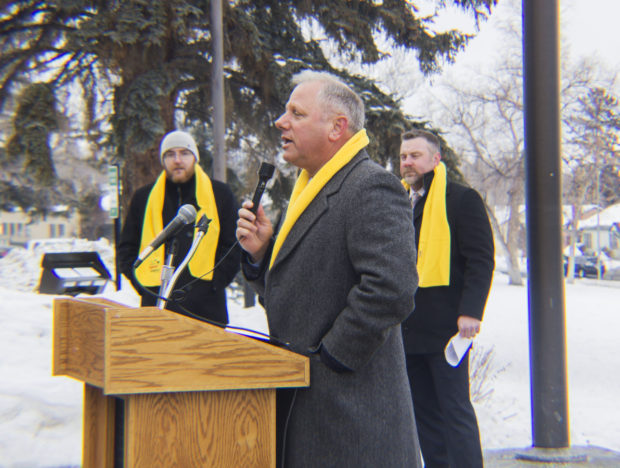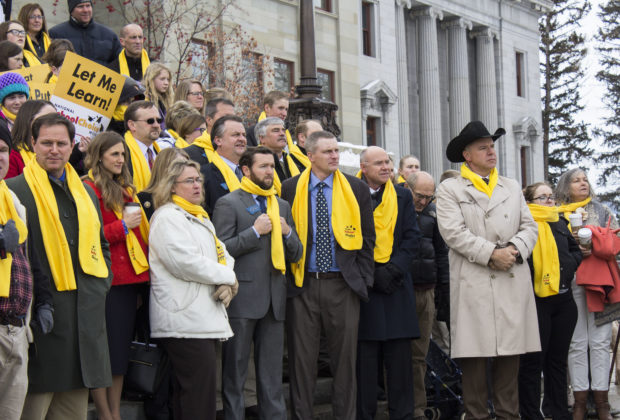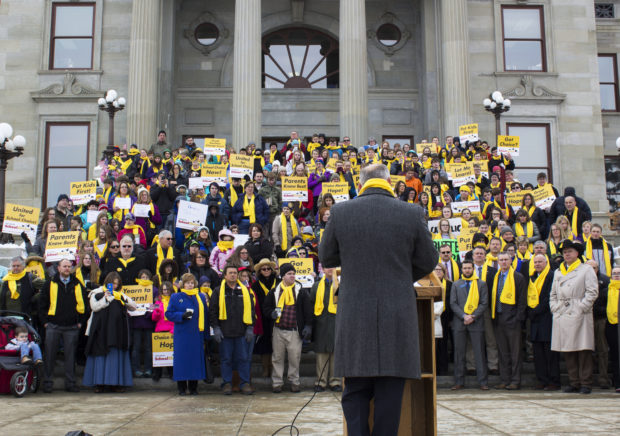News & Updates
The Right Side of Eternity
On Wednesday, we argued against House Bill 417, a bill to include sexual orientation as a protected class in Montana Human Rights law. We argued, as we have for 20 years, that the law would be used to browbeat Christians who don’t want to participate in the homosexual lifestyle.
Yesterday, a Supreme Court decision in the State of Washington proved our point. It was the case of Barronelle Stutzman, a florist who, for over a decade, sold flowers to a man she knew was gay for every occasion imaginable, until the day he asked her to do his wedding. Stutzman told him that she loved him, but she believed marriage was a sacred union ordained by God and reserved to a man and a woman. The gay man said he understood, they both hugged and that was that, or so she thought. Later, through social media, the Washington attorney general heard about the incident and chose to charge Stutzman with a human rights violation.
Yesterday, the Washington Supreme Court ruled that Stutzman, and every other Christian in Washington, could be forced against their faith to participate in same-sex weddings. This is why we fought so hard over the years to keep this law out of Montana. In every state where it passed, homosexual activists have used it to target Christians and get liberal judges to hold religious freedom subservient to homosexual rights. At Wednesday’s hearing, we also pointed out that an ominous change was added to the bill last session. For the first time, those in favor of the bill sought to amend 49-2-404 of the Montana Code, to say that “bathing and dressing facilities, based on the distinction of sex, may be maintained for the purpose of modesty or privacy, as long as individuals are admitted based on their gender identity.”
As I said in an earlier broadcast, the City of New York recognizes 31 gender identities and so would Montana if this were ever to pass. And if it did pass, it would allow men and boys unfettered access to women’s restrooms, locker rooms and shower rooms across the state. That, in our opinion, is absolutely unacceptable. Women and girls should have the assurance that they can undress in a locker room without some guy walking in. I’m sorry to be so graphic, but this is what our society has come to. Fortunately, except for hard members of the progressive left and liberal members of the Montana media, most Montanans still believe in modesty and decency. When the Obama administration issued its transgender mandate to force public schools to allow boys into girls’ locker rooms, we commissioned an extensive state-wide poll. The results were predictable: 29% of Montanans were in favor of the mandate; 62% stood opposed; the Missoula media market saw 38% support, 55% opposed; and of parents with children ages 6 to 11, 15% supported the mandate, while 74% stood opposed.
This is why we’re at the Capitol, to give voice to the vast majority of Montanans who still believe in decency and morality. Toward the end of the hearing, a liberal committee member cautioned those opposed to the bill not to be caught on the wrong side of history. That’s never been my concern. When all is said and done, I don’t want to be on the right side of history, I want to be on the right side of eternity.
Government Gives Me the Creeps
When we talk about government, whether it’s local, state or federal, it’s important to remember it’s kinda creepy.
Now let me explain. Legislators do best when they come into the process with a solid set of core Biblical and Constitutional values. These are the 30,000-foot Overarching Principals, things like: All life is precious from conception until natural death; private property means just that, private; the borrower is slave to the lender; free people are not equal and equal people are not free; AND certain rights are inalienable. They’re given by God, not government, and government cannot take them away. And finally, the power to tax is the power to destroy. These are just a few, but they’re examples of the core principles that produce the smallest government and, therefore, the greatest freedom. Legislators who understand these principles are able to more quickly and more easily decide if a bill is a good bill or a bad bill. Bad bills violate foundational principles, good bills do not.
It’s almost that simple. Legislators who have the most trouble are those that see each bill as an “island entire of itself.” Rather than running it through a grid of foundational principles which usually spits out the right answer, they look at each bill as a unique idea and try to decide whether or not it feels good. These legislators spend their entire session, and sometimes their entire legislative careers, being whipsawed by their emotions. Many times they wind up voting “yes” or “no” on a bill based on whether it’s affordable or not. And most of the time, they don’t even get THAT right because they’re far too willing to raise taxes rather than say “no” to irresponsible spending.
So back to government and the fact that it’s creepy. I don’t mean “creepy” in the sense of a scary movie; I mean “creepy” in the sense that it creeps, slowly but surely, in ever expanding ways to strip citizens of their rights, their responsibilities, their freedoms and their money. The military calls it “mission creep.” I think it goes far beyond the military and applies to all of government. We see examples every day right here in Helena. We have a Constitutional right to defend ourselves using a firearm until lawmakers step into the picture. Then you have the right to defend yourself, except when you’re within so many feet of a school, on a college campus, in a bank or in a government building—makes you wonder why we have so many shootings in schools, on college campuses, in banks and in government buildings like courthouses and post offices.
And what about assisted suicide? Sounds reasonable and fair to many people until we look at the Netherlands where they began with assisted suicide and now have allowed government to creep all the way to involuntary euthanasia. This is what happens when government gets involved and we allow foundational Constitutional principles to be violated by baby steps. It’s human nature, and it’s been the case for as long as government has existed. Our Founding Fathers understood this, and it’s time to remind our legislators and members of Congress, as well. When they violate foundational principles, even for seemingly good reasons, freedom is lost and government gets downright creepy.
It’s Broke. Fix it!
Sometimes in the realm of politics and public policy, it’s time to step back, take a deep breath and admit to ourselves that something is not working.
In the eyes of many policy makers, that time has come for the office of the Montana Commissioner of Political Practices. Since it oversees the election process, it’s always had to deal with contentious issues, but it did a decent job right up until 2011. That’s when Governor Schweitzer, followed by Governor Bullock, began nominating highly-partisan political operatives to fill the post of Montana’s top election cop. Previous governors on both sides of the aisle recognized the need for balance and non-partisanship in such a highly-charged role. They nominated political moderates, and those moderates were confirmed by a state Senate controlled by both Republicans and Democrats; that is, until 2011, the year the train left the tracks.
Governor Schweitzer’s nomination of a highly partisan operative caused Republicans to balk, and she became the first nominee to fail confirmation since the office was established in 1975. Undaunted, Governor Schweitzer then put up two more nominees who failed confirmation. In 2015, Jonathan Motl became the first nominee to be confirmed in four years, but his confirmation was not without controversy. He was also viewed by Republicans as highly political, and they, again, refused to confirm. Motl was only confirmed when a small cohort of liberal Republicans joined with Senate Democrats to provide the necessary votes. Motl was confirmed to fill the last two years of the six-year term that began in 2011. Democrats then filed suit last year, claiming that Motl was entitled to a full six-year term and should be allowed to serve until 2019.
Montana Attorney General Tim Fox then filed a motion asking the court to allow him to intervene and move the case directly to the Montana Supreme Court. He argued that time was of the essence and the Court needed to rule quickly while the 2017 legislature was still in session. The motion was approved, and yesterday the Supreme Court issued its decision saying that Motl’s term did, indeed, expire at the end of 2016, but allowing him to remain in office until a replacement is “qualified,” whatever that means. The strange wording set off another round of debate with Motl saying he would stay in office until a replacement is confirmed, while Senate Republicans say he needs to leave once a nominee is named.
Nothing’s ever easy in this business, and the whole exercise may be moot anyway, since the conventional wisdom is betting that Governor Bullock will nominate Jamie McNaughton, the current number two in the Office of Political Practices, who would then hire Jonathan Motl back as her number two, so that the office never changes.
So what should we do? Clearly, it’s time for a real solution. Other states have political practices offices made up of three or five-member panels so that the power can’t be consolidated in the hands of one political activist. Others don’t even have an office of political practices. A solution set forth in the current Montana legislative session is House Bill 340, which is scheduled for a hearing before the House Judiciary Committee tomorrow morning at 8 a.m. This bill would eliminate the office of political practices and shift the election reporting duties to the Secretary of State’s office, and the enforcement duties to the Attorney General’s office. Whatever the solution, it’s clearly time for a change, because the present system is not working.
National School Choice
It’s always fun when our people come to the Capitol. And yesterday they came by the busload to celebrate National School Choice Week; to celebrate education and the idea that every child deserves the right to find their perfect educational fit, be that public school, private school or homeschool; to celebrate the idea that parents and children together are capable of choosing an educational setting that best fits their child; and to dispel forever the notion that a one-size-fits all education system is still a good idea in the 21st Century.
School choice is an idea whose time has come. It’s a tsunami sweeping the nation, and unfortunately, Montana’s on the lagging edge of the wave. States began implementing school choice about 40 years ago. Some states, like Arizona and Florida, are far down this road. And their students are reaping the benefits. It’s time for Montana to do so, as well.
We began this effort over nine years ago with a tax credit scholarship bill. It was an uphill battle, and opponents of school choice pulled out all the stops. That first bill died on the Senate floor, but it was a start. By the next session, we had six school choice bills, all carried by powerful members of the legislature, bills to establish charter schools and tuition tax credits and tax credit scholarships and education savings accounts, all in an effort to provide a wide array of options for students and their parents. Bills passed out of committee, passed on floor votes and moved between the House and Senate. Momentum was building, and 2013 was a sea change. For the first time in Montana history, we placed a school choice bill on the governor’s desk. Unfortunately, he vetoed it. But the handwriting was on the wall. Montana would eventually join 46 other states in implementing school choice.
And in 2015, it finally happened. Senate Bill 410 was allowed to become law without the governor’s signature. It was a tax credit scholarship bill, and our opponents planned to kill it in court. The State Department of Revenue said that it would not apply to private religious schools, so lawsuits were filed, at both the state and federal levels. This exact same case has already been litigated in Arizona, and went clear to the U.S. Supreme Court, where we won. We’ll win here, too, and when we do, school choice will become a permanent piece of the educational fabric of the State of Montana.
Every year, roughly 1,500 students drop out of Montana Public Schools. In the nine years since we began this effort, over 14,000 students have failed to graduate. What about them? How would their lives be different if they had graduated? Would school choice have made a difference? Possibly. It works in other states, and it can work here, too. That’s why this movement is gaining momentum.
Yesterday’s rally saw 350 people on the front steps of the Capitol, all wearing bright yellow scarves emblazoned with “National School Choice Week.” It was just one of 21,000 similar events held across the U.S. Attendees braved the cold to hear speeches by the Speaker of the House, Americans for Prosperity, ACE Scholarships and the Montana Family Foundation. They also heard letters from U.S. Senator Steve Daines and Superintendent of Public Instruction, Elsie Arntzen. It was all-hands-on-deck for kids, and you can see the pictures on our website at montanafamily.org.
National School Choice Week Rally
A crowd of more than 350 gathered on the steps of Montana’s capitol building on Wednesday, January 25th. Part of National School Choice Week, the event raised awareness of how school choice helps every student find their perfect educational fit.

Montana Family Foundation President/CEO Jeff Laszloffy speaking at the school choice rally.
Organized by the Montana School Choice Coalition, which includes ACE Scholarships, Big Sky Scholarships, Americans for Prosperity, the Montana Family Foundation, Montana Catholic Schools, the Montana Federation of Independent Schools, and the Montana Policy Institute, the rally was an overwhelming success. Over a dozen legislators came out to hear about school choice bills proposed for this session.

ACE Scholarships State Director Jake Penwell speaking at the Montana school choice rally
Check out more pictures of the amazing Montana school choice rally!

The crowd at the Montana school choice rally, featuring Americans for Prosperity director David Herbst, Senator Steve Hinebauch, and hundreds more!

Another shot of the crowd at the Montana school choice rally, featuring Representatives Derek Skees, Don Jones, Peggy Webb, Bob Brown, Seth Berglee, Carl Glimm, and Mark Noland; Senator Eric Moore, and school choice supporters from all across Montana.

A crowd of about 400 listens as Montana Family Foundation President/CEO Jeff Laszloffy speaks about school choice.
